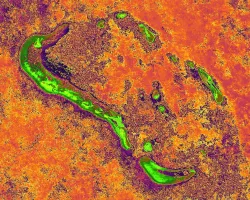
Landslides and flooding are reoccurring environmental hazards that lead to health risks and economic burdens in the urban areas of Cincinnati, Ohio and Covington, Kentucky. These communities share underlying natural and artificial conditions that make them vulnerable to these hazards, including excessive precipitation, weak lithology, high impervious surface levels, and steep slopes. Despite the human and economic risks associated with these environmental hazards, the areas of highest vulnerability within the region remain unknown. NASA DEVELOP partnered with Groundwork USA and Groundwork Ohio River Valley (ORV) to assess the region’s susceptibility to landslides and flooding. The team utilized NASA Earth observations, including the Landsat 8 Operational Land Imager (OLI), Landsat 8 Thermal Infrared Sensor (TIRS), and Global Precipitation Measurement (GPM) Integrated Multi-satellitE Retrieval for GPM (IMERG), alongside ancillary datasets to map landslide susceptibility and exposure throughout the study area. The team also used ancillary data to map surface runoff and runoff retention using the Natural Capital Project’s Integrated Valuation of Ecosystem Services and Tradeoffs (InVEST) Urban Flood Risk Mitigation Model. The resulting landslide susceptibility and exposure maps highlight the neighborhoods around Avondale and Fairmount as areas of particularly high landslide exposure. Meanwhile, the InVEST outputs demonstrate that Downtown Cincinnati and the Queensgate neighborhood retain the least amount of rainfall. This research provides partners with a more complete hazard analysis of the greater Cincinnati area while also producing refined methodologies to enhance future flood and landslide vulnerability mapping throughout Groundwork USA’s nationwide network of communities.



